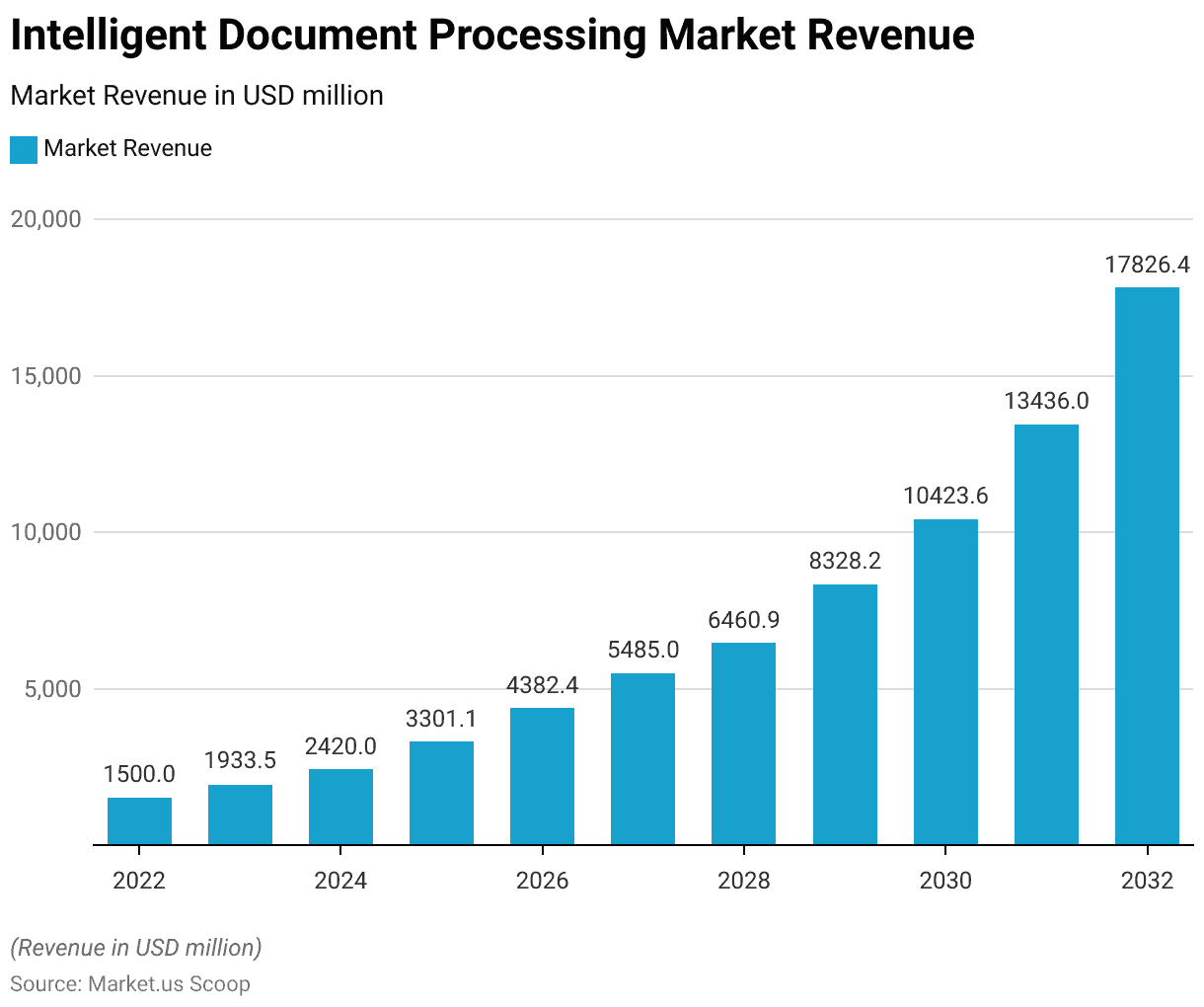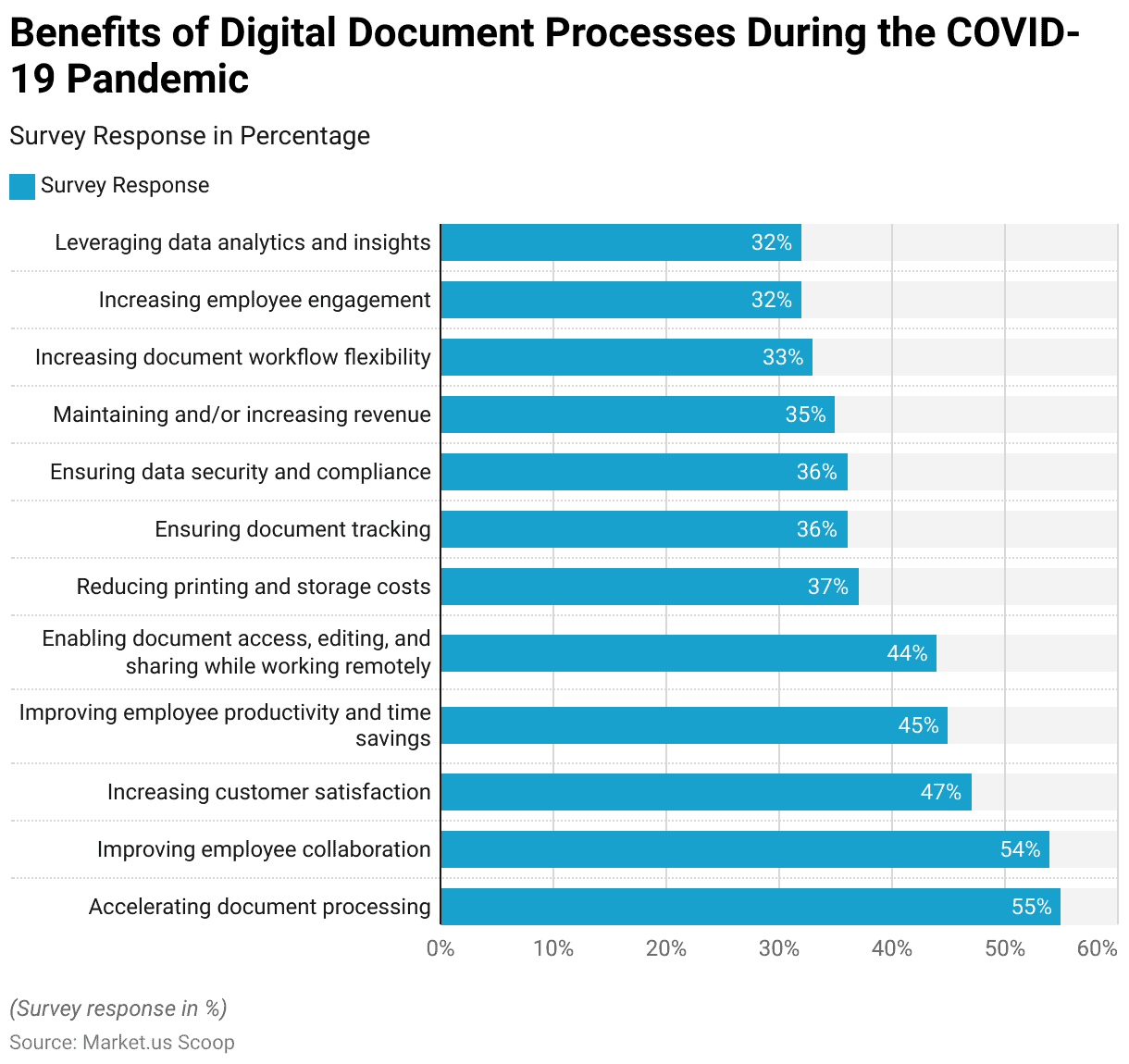Table of Contents
Introduction
According to Intelligent Document Processing Statistics, Intelligent Document Processing (IDP) is a technology-driven approach that uses Optical Character Recognition (OCR), Natural Language Processing (NLP), Machine Learning (ML), and Artificial Intelligence (AI) to automate data extraction from documents, enhancing efficiency and reducing errors.
IDP finds application in diverse sectors, including banking, healthcare, legal, retail, and manufacturing. Benefits encompass improved efficiency, error reduction, cost savings, and enhanced compliance. However, IDP faces challenges related to data quality, integration, scalability, and data security, with an increasing role expected in streamlining document-centric processes.
Editor’s Choice
- The Intelligent Document Processing (IDP) market is experiencing robust growth, with its revenue projected to witness a substantial increase over the next decade at a CAGR of 28.9%.
- In 2022, the IDP market generated USD 1,500.0 million in revenue and is expected to rise to USD 17,826.4 million in 2032.
- Solutions dominate the components landscape with a substantial majority, accounting for an impressive 64.8% of the market.
- Studies suggest that unstructured data makes up 80-90% of newly generated data in enterprises.
- Concerning the advantages of document processing during COVID-19, the most crucial advantages include the acceleration of document processing, which garnered 55% of the votes, closely followed by the enhancement of employee collaboration at 54%.
- IDP can potentially cut processing time by 50% or even more, eliminating errors and profoundly boosting productivity and efficiency.
- Implementing IDP can significantly lower the chance of errors by more than half, reducing the risk by 52% or greater.
- IDP has the potential to attain an impressive accuracy rate of 99%.
Global Intelligent Document Processing Market
Global Intelligent Document Processing Market Size
- The Intelligent Document Processing (IDP) market is experiencing robust growth, with its revenue projected to witness a substantial increase over the next decade at a CAGR of 28.9%.
- In 2022, the IDP market generated USD 1,500.0 million in revenue, expected to rise to USD 1,933.5 million in 2023.
- By 2032, the market is anticipated to reach an impressive USD 17,826.4 million in revenue, highlighting the increasing adoption of intelligent document-processing solutions across various industries.

Intelligent Document Processing Market Size – By Deployment Mode
- The global market for Intelligent Document Processing is projected to experience substantial growth from 2022 to 2032.
- In 2022, the total market revenue is estimated at USD 1,500 million, with cloud-based deployment accounting for USD 876 million and on-premise solutions for USD 624 million.
- A steady rise is expected in the following years, with 2023 increasing to USD 1,933.5 million overall, of which USD 1,129.2 million would be cloud-based and USD 804.3 million on-premise.
- By 2028, the market is expected to grow to USD 6,460.9 million, with cloud-based solutions contributing USD 3,773.2 million.
- An even larger expansion is projected for 2029, with the market reaching USD 8,328.2 million, cloud-based revenues hitting USD 4,863.6 million, and on-premise revenues at USD 3,464.5 million.
- The subsequent years will see a continuation of this growth, with the total market expected to reach USD 10,423.6 million in 2030, USD 13,436 million in 2031, and an impressive USD 17,826.4 million by 2032, with cloud-based deployment modes driving the majority of the revenue, forecasted at USD 10,410.6 million in the final year.

Global Intelligent Document Processing Market Share – By Component
- In the global Intelligent Document Processing (IDP) market, market share distribution by component is quite distinctive.
- Solutions dominate the landscape with a substantial majority, accounting for an impressive 64.8% of the market.
- This highlights IDP software’s and technology’s significance in automating document processing tasks.
- On the other hand, services also play a substantial role, capturing 35.2% of the market share. This category likely includes consulting, implementation, training, and support services, which are vital in ensuring the effective deployment and maintenance of IDP solutions.

Documents with Structured vs. Unstructured Data
- According to Gartner, unstructured data refers to machine-printed or handwritten content that doesn’t follow predetermined rules or guidelines that computers usually rely on for classification and recognition.
- Unstructured data can take various forms, including text and non-text data, like photos with handwritten notes. It can also be found in databases that don’t follow traditional relational structures, such as NoSQL.
- Studies suggest that unstructured data makes up 80-90% of newly generated data in enterprises.
- Surprisingly, only a small fraction, specifically 18% of organizations, are harnessing the potential of this resource.
- This means that the majority, about 82%, are not fully leveraging their most valuable asset.
IDP and Optical Character Recognition (OCR)
- While intelligent document processing (IDP) is centered around AI, optical character recognition (OCR) is crucial in enabling end-to-end document processing within IDP.
- OCR is just one component in the architecture of intelligent document processing, and it’s important to note that not all OCR solutions available in the market are equal.
- Various companies have emerged, offering technology recognizing machine-printed characters and handwritten text.
- Legacy vendors started addressing Optical Character Recognition as early as the 1980s.
- Despite decades of research, many off-the-shelf OCR technologies still struggle to decipher handwriting today accurately.
- Even with high-quality scanners and well-prepared documents, OCR typically achieves only a 60% accuracy rate before encountering limitations.
IDP vs. RPA vs OCR
- Intelligent document processing (IDP) significantly departs from older automated data processing systems. Unlike its predecessors, IDP captures information from documents and comprehends the context in which the data is presented.
- This expanded capability enables organizations to automate more document-related tasks than possible.
- In contrast, the primary tool for automation until now has been robotic process automation (RPA), which relies on recording basic mouse movements to automate repetitive tasks via the user interface.
- RPA typically follows predefined steps, termed a “template,” to execute more complex screen-based tasks.
- In the early 2000s, screen scraping software was an early application of RPA, acting as a temporary solution to bridge the gap between newer and older, incompatible legacy systems.
- Today, RPA proves effective in streamlining routine, non-document-centric tasks conducted on computer screens.
Benefits of Digital Document Processes During the COVID-19 Pandemic
- In the context of the COVID-19 pandemic, digital document processes have brought significant benefits to organizations.
- According to survey responses, the most crucial advantages include accelerating document processing, which garnered 55% of the votes, closely followed by enhancing employee collaboration at 54%.
- These digital processes have also increased customer satisfaction (47%) and improved employee productivity, resulting in time savings (45%).
- Additionally, they’ve facilitated document access, editing, and sharing while enabling remote work (44%).
- Other notable benefits include reductions in printing and storage costs (37%), ensuring document tracking and data security and compliance (both at 36%), and maintaining or even increasing revenue (35%).
- Furthermore, digital document processes have enhanced document workflow flexibility (33%), increased employee engagement (32%), and provided opportunities to leverage data analytics and gain valuable insights (32%).

Benefits of IDP Implementation
- Companies that have embraced IDP solutions to automate their workflows have experienced significant benefits, including a remarkable reduction in processing time and a substantial decrease in labor costs, often reaching up to 30%.
- IDP can potentially cut processing time by 50% or even more, eliminating errors and profoundly boosting productivity and efficiency.
- The introduction of automation into the workplace typically results in a return on investment (ROI) ranging from 30% to 200% within the first year, primarily driven by savings in labor costs.
- Employees can allocate more creative energy to the company’s core activities by eliminating time-consuming tasks.
- For example, an IDP implementation saved a financial services company approximately $2.9 million annually by halving its manual extraction workforce.


